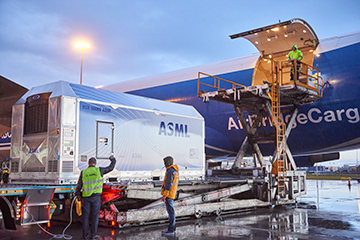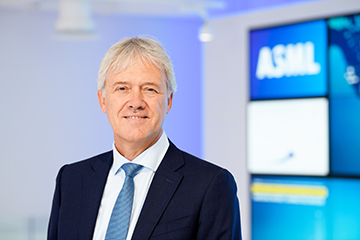
An ASML system container is prepared for shipment. [Image: ASML]
In mid-July, the Netherlands-based lithography equipment manufacturer ASML reported that it had logged net sales of €5.43 billion (US$5.51 billion) and net income of €1.41 billion (US$1.43 billion) for the three months ended 2 July 2022, the second quarter of its fiscal year. The results amounted to a 35% year-to-year sales increase and a similarly hefty percentage gain in net income. ASML also reported that it had booked €8.5 billion in new orders during the period, a company record for a single quarter.
ASML develops and sells complex, expensive equipment for nanoscale semiconductor lithography that uses extreme-ultraviolet (EUV) radiation, generated from laser-driven plasmas and directed using exquisitely tuned EUV optics. The record orders for the 2022 second quarter are a signal, the company believes, that its semiconductor-manufacturing clients still have plenty of long-term appetite for these sophisticated systems. Driving that long-haul demand, according to ASML, are “global megatrends in automotive, high-performance computing, and green-energy transition.”
That said, the company also acknowledged that the near term could be somewhat rockier, as ASML—like many other firms—deals with supply-chain constraints, inflation and the potential for recession in the coming year. Those factors, the company said, could lead to near-term delays in recognizing revenue and some pressure on gross margins.
Fast shipments = slow revenue recognition
Reviewing the quarterly results in a company-sourced interview, ASML’s CEO, Peter Wennink, said that in the short term “there is no denial that there are concerns.” Those concerns have largely stemmed from supply-chain constraints—“parts not coming on time,” as Wennink put it.
This, in turn, has delayed the completion of booked business and has led ASML to resort to a larger-than-planned number of “fast shipments.” In such arrangements, the company’s big lithography machines are shipped in advance of final factory testing, with the final testing actually conducted after the device is installed and running on the customer site.
Fast shipment can clip up to a month off of the time it takes to get machines actually working and contributing to the customer’s wafer output capacity—“very important,” Wennink said, “when the customers are waiting for those machines.” But perhaps paradoxically, given the name, fast shipments also tend to delay the final customer acceptance date and, thus, revenue recognition for ASML.
Demand unabated

Peter Wennink, ASML president and CEO. [Image: Bart van Overbeeke Fotografie / courtesy of ASML]
For the 2022 full fiscal year, the company now believes that this combination—supply-chain constraints and consequent increased reliance on fast shipments—could push around €2.8 billion in revenues that would otherwise have been booked in the current year into 2023. But Wennink emphasized that this was very much a timing issue, tied to near-term supply constraints. “The demand is still significantly higher than we can make,” he said. “We don’t see any demand reduction. But … shipments will indeed be later.”
Wennink did acknowledge, though, that in an inflationary environment, the company’s profit margins could narrow a bit—both because of increases in labor and parts costs, and because fewer near-term revenues will be available to cover fixed costs (which are also increasing). Thus, while ASML started the year anticipating gross margins of around 53% for 2022, it has now dialed back that full-year expectation to the area of 49% to 50%.
Longer-term picture
Looking beyond these near-term issues, Wennink stressed the long-term case for continued growth for ASML. He pointed out that, even in the event of a moderate recession next year, the long-lead-time nature of the machines and their “very critical” role in advanced, next-gen semiconductor manufacturing will keep demand high—a message, he maintained, that ASML was hearing from its customers.
And, looking beyond the current economic and geopolitical disruptions, Wennink said “there is no denying that the digital transition that’s taking place will continue.” He pointed to increases in both semiconductor content and “litho intensity” in markets such as the automotive arena—where customers, he suggested, are looking at “a quadrupling or quintupling of semiconductor content”—as well as in solar and smart-grid technologies tied to clean energy, in the “internet of everything,” and in high-performance computing.
“It’s happening,” he said, “and will not go away.” Thus, Wennink maintained, while the company continues to see “mixed signals” in the short term, it thinks the trends in place will provide “a very, very healthy growth profile” looking further out.
